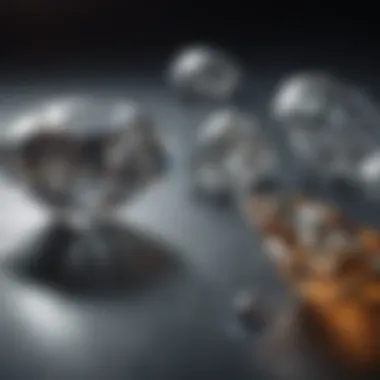Are Man-Made Diamonds Considered Minerals? Deciphering the Debate


Rock and Fossil Identification
In the realm of mineralogy, the classification of laboratory-grown diamonds as minerals sparks a compelling debate. These gems, crafted through human intervention rather than formed naturally, present intricate scientific characteristics that challenge traditional definitions. The process of identifying rocks and fossils, specifically diamonds, demands a keen eye for detail. Natural diamonds, excavated from the earth, bear distinct characteristics that set them apart from their synthetic counterparts. Various tools, ranging from magnifiers to spectrometers, aid enthusiasts in distinguishing between natural and lab-created diamonds.
Geological Insights
Delving deeper into the geological aspects, the formation processes of natural diamonds unveil a story millions of years in the making. Geological formations play a crucial role in the creation of diamonds, with pressure and temperature conditions shaping their unique properties. Understanding these geological processes sheds light on the rarity and value of natural diamonds. Through historical accounts and notable discoveries, the significance of diamonds in geological contexts emerges as a fascinating aspect of their classification as minerals.
Preservation and Display
Preserving the integrity of diamonds, whether mined or manufactured, requires specialized techniques. Advanced preservation methods ensure the longevity and luster of these precious stones. Proper storage, away from harsh environmental conditions, safeguards the brilliance of diamonds for generations to come. When it comes to displaying diamonds, enthusiasts explore creative avenues to showcase these marvels of nature and craftsmanship.
Collecting Tips and Techniques
For collectors seeking to expand their range, mastering the art of diamond collection is a captivating journey. Best practices in collecting emphasize ethical sourcing and responsible acquisition. Locating prime sites for diamond collection involves research and collaboration with experts in the field. Extracting specimens safely and ethically is paramount in preserving the natural beauty inherent in diamonds.
Introduction
In the dynamic world of gemology, the question of whether laboratory-grown diamonds can be classified as minerals sparks intrigue and prompts a closer examination. This article aims to delve deep into this captivating subject, shedding light on the scientific nuances that underpin the argument. By exploring the distinctions between naturally occurring diamonds and their synthetic counterparts, we can unravel the complex web of characteristics that define minerals.
Defining Minerals
When it comes to defining minerals, precision is key. Minerals are naturally occurring inorganic substances with a specific chemical composition and distinct crystalline structure. These elements combine to form a unique fingerprint for each mineral, allowing geologists and gemologists to distinguish one from another. The defining features of minerals provide a robust framework for understanding their properties and origins.
The Mystique of Diamonds
Diamonds, revered for their unparalleled beauty and strength, possess a mystique that transcends cultures and time. Their formation deep within the Earth's crust over millions of years imbues them with a sense of rarity and wonder. The allure of diamonds lies not only in their physical attributes but also in the symbolism and emotion they evoke. This section will explore the enigmatic appeal of diamonds and their enduring significance.
Growing Interest in Laboratory-Created Diamonds


The emergence of laboratory-created diamonds has sparked a wave of interest and discussion within the gemological community. As technology advances, scientists can now replicate the conditions that give rise to natural diamonds, leading to the creation of high-quality synthetic gems. The ethical considerations, cost-effectiveness, and environmental impact of lab-grown diamonds have paved the way for an intriguing debate on their status as minerals. This section will delve into the multifaceted nature of laboratory-created diamonds and their implications for the field of mineralogy.
Characteristics of Minerals
In this section, we delve into the significant realm of Characteristics of Minerals, a pivotal topic in the discourse focusing on the mineralogical world and the captivating question of whether laboratory-created diamonds can be deemed as minerals. Understanding the specific characteristics of minerals holds immense importance as it forms the bedrock for discerning between natural and synthetic elements. By delving into the intricate realms of mineral characteristics, we equip ourselves with the necessary knowledge to discern the essence and composition of substances that adorn the earth's crust and beyond.
Chemical Composition
Chemical Composition stands as a fundamental pillar in the study of minerals, providing invaluable insights into the elemental makeup of substances under scrutiny. For diamonds, this aspect unveils the precise arrangement of atoms, bonding configurations, and the intricate dance of elements that culminate in the captivating structure of these gems. Unraveling the chemical composition of laboratory-created diamonds vis-a-vis their natural counterparts sheds light on the nuances that define mineral classification and the evolving landscapes of scientific exploration.
Crystal Structure
Crystal Structure emerges as a cornerstone in the analysis of minerals, offering a peek into the geometric arrangements and symmetrical patterns that govern the physical manifestation of substances. In the context of diamonds, a close examination of crystal structure unravels the mesmerizing lattice framework that bestows these gems with their renowned brilliance and allure. Comparing the crystal structures of natural and laboratory-created diamonds unveils intriguing similarities and disparities, inviting further exploration into the realms of mineral formation and synthesis techniques.
Formation Process
The Formation Process of minerals unveils the captivating journey from raw elements to crystalline wonders, encapsulating the essence of geological time and transformative forces at play. For diamonds, understanding the formation process unravels tales of immense pressure, temperature, and elemental interactions that converge to create these natural masterpieces. Exploring the formation processes of laboratory-created diamonds provides a contrasting narrative, shedding light on the innovative techniques that mimic nature's artistry in controlled settings while raising pertinent questions on the classification criteria and mineralogical definitions.
Diamonds: Natural vs. Laboratory-Created
In the realm of diamonds, the dichotomy between natural and laboratory-created specimens stands at the forefront of discussions within this article. The distinction between these two types of diamonds holds immense importance, as it sheds light on the complexities of the diamond industry and the evolving perspectives on gemstone creation and authenticity. Natural diamonds, formed through centuries in the Earth's depths, come with a rich history and allure that captivates enthusiasts and collectors worldwide. On the other hand, laboratory-created diamonds, synthesized through advanced technological processes, offer a modern twist to traditional diamond production.
Natural Diamonds
Mining Process
The mining process plays a pivotal role in the narrative of natural diamonds. The extraction of these precious gems from deep within the earth's mantle involves a meticulous operation that combines state-of-the-art machinery with skilled labor. The mining process contributes significantly to the overall theme of this article by highlighting the arduous journey diamonds undertake from their formation to the hands of collectors. It stands as a testament to human endeavor and technological innovation, bringing to light the challenges and triumphs involved in obtaining these natural wonders. The uniqueness of the mining process lies in its ability to unearth hidden treasures while ensuring ethical and sustainable practices in an industry driven by rarity and beauty.
Origin and Age
Origin and age form the intrinsic characteristics that define natural diamonds' essence. Understanding the geographical source and the age of a diamond provides valuable insights into its formation and journey through time. Delving into the origin and age of natural diamonds enriches the overall discourse of this article by unraveling the geological wonders that create these extraordinary gems. The authenticity of a diamond's origin and the tale woven by its age serve as poignant markers of its enduring value and antiquity, resonating with collectors and enthusiasts who appreciate the natural marvels crafted by the Earth over millennia.


Laboratory-Created Diamonds
Synthesis Techniques
Synthesis techniques represent the crux of laboratory-created diamonds, showcasing the precision and innovation embedded in their creation. These techniques play a vital role in producing diamonds that mirror the chemical composition and physical attributes of their natural counterparts. Delving into the intricacies of synthesis techniques enriches the discourse of this article by shedding light on the cutting-edge methods employed in modern gemstone production. The accuracy and efficiency of these techniques underscore the evolution of diamond synthesis, offering collectors and enthusiasts a glimpse into the future of sustainable and ethical gemstone creation.
Physical Properties
The physical properties of laboratory-created diamonds serve as key indicators of their authenticity and quality. By examining these properties, such as hardness, color, and clarity, enthusiasts gain a comprehensive understanding of the unique characteristics that define laboratory-created diamonds. Exploring the nuances of physical properties contributes significantly to this article by delineating the similarities and differences between natural and synthetic diamonds. The scientific examination of these properties reveals the sophistication and precision embedded in laboratory-created diamonds, fostering a deeper appreciation for the technological advancements driving innovation in the gemstone industry.
Mineral Classification Criteria
In this section, we delve into the critical topic of Mineral Classification Criteria and its significance within the broader discussion on whether diamonds created in a laboratory qualify as minerals. Understanding the criteria for classifying minerals is essential in distinguishing between natural and synthetic diamonds, aiding in determining their scientific categorization and commercial value. By examining the specific characteristics that define a mineral, such as chemical composition, crystal structure, and formation process, we can draw informed conclusions regarding the mineral status of laboratory-grown diamonds.
Traditional Criteria
Traditional criteria for mineral classification have long been established through a set of characteristics that define minerals in their natural form. These criteria typically include specific chemical compositions, crystalline structures, and methods of formation. By adhering to these traditional benchmarks, geologists and mineralogists can categorize minerals based on their inherent properties and geological origins. While these criteria have laid the foundation for mineral classification, modern advancements and perspectives have introduced new elements into the discourse.
Modern Perspectives
In recent years, modern perspectives on mineral classification have evolved to incorporate a more nuanced understanding of minerals, especially in light of technological advancements such as diamond synthesis techniques. Modern criteria now consider not only the traditional chemical and physical attributes of minerals but also their industrial applications, sustainability factors, and ethical considerations. This multidimensional approach reflects the complex nature of laboratory-crafted diamonds and the shifting landscape of mineral classification in the 21st century. By embracing modern perspectives, we can navigate the intricate terrain of mineralogical classification with depth and insight, offering a more holistic view of diamonds created in a laboratory and their place within the mineral kingdom.
Debating the Mineral Status of Lab-Grown Diamonds
In the realm of gemology and mineralogy, the ongoing debate surrounding the classification of laboratory-grown diamonds as minerals holds substantial significance. This contentious topic delves into the fundamental question of whether diamonds produced in a controlled laboratory environment can be regarded as true minerals. By scrutinizing the distinct attributes and characteristics of these synthetically-created diamonds against their naturally-occurring counterparts, individuals from various scientific and commercial sectors aim to establish a definitive stance on this intriguing matter. The exploration of the mineral status of lab-grown diamonds serves as a pivotal focal point in this article, shedding light on the complexities and nuances surrounding the definition and categorization of minerals within the context of modern gemstone research and technology.
Scientific Arguments
Atomic Structure Analysis


Atomic structure analysis plays a crucial role in unraveling the intrinsic composition and arrangement of atoms within diamonds, thereby contributing significantly to elucidating the mineralogical status of laboratory-created gems. By employing advanced techniques such as X-ray diffraction and spectroscopy, scientists can discern the precise crystalline structure and bonding patterns present in these synthetic diamonds. This method enables researchers to scrutinize the lattice configuration and atomic integrity of lab-grown diamonds, offering invaluable insights into their authenticity and mineralogical characteristics. Despite its meticulous nature, atomic structure analysis stands as a robust and widely utilized tool in the thorough examination of synthetic diamonds, facilitating a detailed comparison with their natural counterparts to determine their mineral classification.
Isotopic Signatures
The analysis of isotopic signatures represents another pivotal aspect in the scientific evaluation of both natural and laboratory-created diamonds, contributing significantly to the ongoing discourse on their mineral status. Isotopic signatures refer to the unique isotopic ratios of elements present in diamonds, serving as distinctive markers of their origin and formation processes. By scrutinizing these isotopic compositions through mass spectrometry and other isotopic analysis techniques, researchers can gain insights into the geological provenance and synthetic origins of diamonds. This analytical approach plays a critical role in distinguishing between natural and synthetic diamonds based on their isotopic fingerprint, guiding the assessment of their mineralogical identity and facilitating a comprehensive examination of their geological and artificial characteristics.
Section 6: Future Perspectives
In this section, we will delve into the future perspectives regarding the classification of laboratory-grown diamonds as minerals. This aspect is crucial in understanding the evolving landscape of the diamond industry and the implications for collectors and enthusiasts. By exploring the advancements in technology and the ethical considerations surrounding lab-grown diamonds, we aim to provide a forward-looking outlook for our readers. The future perspectives discussed here will shed light on the potential developments in diamond synthesis methods and the ethical challenges that need to be addressed.
Technological Advancements
Diamond Synthesis Innovations:
The field of diamond synthesis innovations plays a pivotal role in shaping the future of laboratory-grown diamonds as minerals. One notable aspect of diamond synthesis innovations is the advancement in chemical vapor deposition (CVD) techniques, which allow for the creation of high-quality diamonds in a controlled environment. The key characteristic of CVD technology is its ability to replicate the natural diamond growth process, resulting in gem-quality stones that are visually identical to mined diamonds. This method is highly advantageous for our article as it showcases a sustainable approach to diamond production, reducing the environmental impact associated with traditional mining practices. One unique feature of CVD technology is its scalability and consistency in producing diamonds, making it a popular choice for manufacturers and researchers alike. The advantages of CVD synthesis lie in its cost-effectiveness, as it allows for the production of diamonds at a lower cost compared to natural mining processes, while also promoting ethical sourcing practices. However, a potential disadvantage of CVD technology is the ongoing debate surrounding the disclosure of lab-grown diamonds to consumers and the need for clear labeling to distinguish them from natural stones.
Ethical Considerations
Sustainability Issues:
Sustainability issues are at the forefront of the ethical considerations surrounding laboratory-grown diamonds and their mineral classification. The key characteristic of sustainability in diamond production lies in the reduced environmental footprint of lab-grown diamonds compared to their mined counterparts. By utilizing sustainable energy sources and minimizing material waste, synthetic diamond producers aim to create a more environmentally friendly alternative to traditional mining practices. This emphasis on sustainability is essential for our article as it highlights the importance of responsible resource management in the jewelry industry. The unique feature of sustainability in lab-grown diamonds is its potential to mitigate the negative impact of diamond mining on local ecosystems and communities, making it a beneficial choice for environmentally conscious consumers. However, a disadvantage of sustainable diamond production is the need for ongoing research and development to further improve the efficiency and eco-friendliness of the manufacturing process.
Social Impact:
The social impact of lab-grown diamonds is another crucial aspect to consider when exploring the ethical dimensions of mineral classification. One key characteristic of the social impact is the empowerment of local communities through job creation and skills development in the lab-grown diamond sector. By providing sustainable employment opportunities and supporting education initiatives, synthetic diamond producers can contribute to the socio-economic development of diamond-producing regions. This emphasis on social impact is advantageous for our article as it underscores the potential positive outcomes of ethical sourcing practices in the jewelry industry. The unique feature of social impact in lab-grown diamonds is its ability to foster transparency and accountability in the supply chain, helping to build consumer trust and confidence in the origin of their jewelry. Despite these benefits, a potential disadvantage of the social impact is the need for continued monitoring and evaluation to ensure that ethical standards are upheld throughout the diamond production process.
Conclusion
In the realm of mineral classification, the inquiry into whether laboratory-grown diamonds can be designated as minerals carries significant weight. This deliberation adds a layer of complexity to the already intricate discourse surrounding gemstones and their categorization. By scrutinizing the atomic and structural composition of diamonds, researchers can gain deeper insights into the fundamental attributes that define minerals. Moreover, exploring the nuances between natural and synthetic diamonds provides a unique perspective on the evolution of mineralogy in contemporary times. This article navigates through the scientific and theoretical dimensions of this debate, offering a comprehensive analysis that sheds light on the intricate connection between diamonds and the mineral kingdom.
Revisiting the Question
Upon reassessing the central question of whether laboratory-crafted diamonds should be acknowledged as minerals, it becomes apparent that the answer is contingent upon a multifaceted evaluation. Factors such as the genesis of diamonds, their chemical structure, and the process of growth play pivotal roles in determining their classification within the mineral spectrum. Delving into the isotopic signatures and atomic arrangements of diamonds presents a compelling argument for their inclusion as minerals, albeit manufactured under controlled conditions. This reconsideration prompts a reevaluation of traditional mineral criteria, inviting a paradigm shift in the perception of gemstones engineered through human intervention.
Implications for Collectors and Enthusiasts
For collectors and enthusiasts immersed in the allure of diamonds, the discourse on the mineral status of lab-grown diamonds holds significance in various dimensions. Understanding the pivotal role played by technological advancements in diamond synthesis allows collectors to appreciate the intricate artistry behind laboratory-created gems. Moreover, ethical considerations revolving around sustainability and social impact provide a holistic perspective for enthusiasts to contemplate their engagement with diamonds. By delving into the implications of this debate, collectors can navigate the evolving landscape of diamond acquisition with a nuanced understanding of the mineralogical and ethical ramifications.







